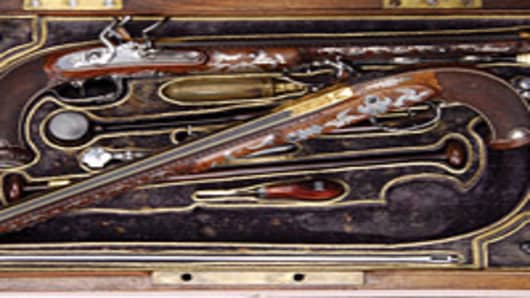Many different weapons and armors are available to collectors; like securities, different market segments are influenced by different forces.
Fagan cites these examples:
- Spanish colonial weapons: “Disproportionate increase in prosperity, interest in Hispanic culture, and the perception that Spanish colonial culture has been under-represented in museums has caused a dramatic increase in values, about four-fold in 15 years.”
- Scottish weapons: Popular because of the Scots’ fight for freedom from English rule.
- Russian weapons: “The new prosperity for the Russian business class has caused a demand for all Russian art, including weapons, with values probably tripling in the last decade, and best items achieving values of probably 10-fold in that time.”
- Islamic arms and armor: These have increased about 500 percent in value since 1990.
“Some increases respond to market trends,” says Fagan. “The Civil War centennial (1965) and Revolutionary War bicentennial (1976) both caused spikes in interest in the respective weapons, followed by flat or declining interest.”
Business Booming in Antique Weapons
There’s scant analysis on the size of the collectible arms industry, but Antique Arms Show Director Wally Beinfeld says he has watched it grow substantially in the past 50 years.
He says his show is an example. In 1961, he explains, it hosted about 30 dealers in Las Vegas, and around $80,000 worth of weapons changed hands. In January 2012, Beinfeld says about 700 vendors will attend and about $12 million of weapons will change hands. The federal Bureau of Alcohol, Tobacco and Firearms estimates that 2 million used firearms change hands in the U.S. each year.
Of those 2 million used guns, not all will be highly prized. Collectors and dealers agree on a handful of characteristics that determine the value, including scarcity, demand, condition and previous ownership. Lane says an aspiring collector should first read and research the specific weapon and try to see them in person before buying so as not to fall for a reproduction.
An edgy back story and high public interest can yield very high prices.
In June, Christie’s auction house sold a .38-caliber Colt Police Positive revolver from the 1920s. CollectorsFirearms.com routinely lists Colt Police Positive .38s for around $1,000, but the Christie’s pistol went for $109,000. It had been owned by Al Capone, and came with a paper trail attesting its origins.
“The Capone Colt was a very special piece,” says Christie’s Arms and Armour expert Howard Dixon. “Over the years, I have sold firearms which Sir Henry Morton [Stanley] carried on his famous expedition to find Dr. Livingstone, a revolver which Lord Lovat stormed ashore brandishing on D-Day, and a sword which had been carried into battle at Waterloo in 1815 — to name but a few.”
Many antique arms buyers are primarily interested in a collectible weapon’s history, and find numerous opportunities to buy at friendlier price points.
Mel Bergman, a digital strategist for an interactive design agency in California, collects war-time firearms. Many of his favorites were mass-produced for marching armies and are still relatively affordable, like the Japanese Arisaka Type 99, made during World War II, which he recently bought for $400.
He believes that fairly common weapons will increase in value — much like Fagan’s armor. Meanwhile, Bergman collects an emotional dividend — the satisfaction of bearing antique arms.
“The pleasure for me with old firearms is handling them, looking at them, and firing them,” Bergman says. “History becomes much more alive when you are firing a weapon that was used in anger. It really imparts a whole new appreciation.”



